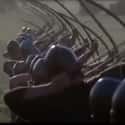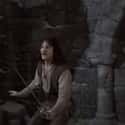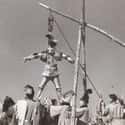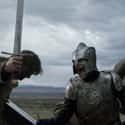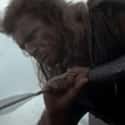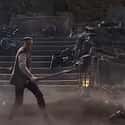-
(#12) Arrows Were Like Modern-Day Artillery
Movies and TV shows make longbows out to be even more dangerous than they actually were. During Braveheart's Battle of Falkirk, for example, Longshanks orders his archers to fire on the Scots while they fight with the English, to devastating effect. Longbows act like modern-day artillery pieces, raining down doom from long range, and either softening an army for an infantry assault or destroying it outright. Longbows are essentially medieval super-weapons.
In reality, while longbows were an important component of medieval warfare, they weren't the one decisive factor. Armies did use them to thin out enemy ranks, but they couldn't wipe out an enemy army entirely - and that usually wasn't the goal anyway. More often, longbows were used to harass the enemy to lower their morale, or to contain the enemy's position so it couldn't make a flanking maneuver.
-
(#2) Sword Fighting Was Like A Lethal Form Of Break Dancing
When two characters fight one-on-one with swords (which would be unlikely to happen on a battlefield anyway), it often resembles an elaborately choreographed dance routine. A typical movie sword fighter might use backflips, somersaults, spin moves, and other kinds of fancy footwork. And if they can toss off a few clever quips, even better.
That type of sword fighting is really a form of 19th-century aristocratic dueling. Medieval sword fighting was a lot more brutal. Hundreds of sword fighting training manuals from the Middle Ages have survived to the present. These manuals advise fighters to win at all costs, including many techniques that might be considered unchivalrous. They typically encourage medieval sword fighters to act quickly and aggressively, and to attack an opponent's weak spots in order to immobilize them and finish them off.
In a real battle, doing a spin move would have been particularly dangerous, because it leaves your back exposed to the enemy (unless they're also doing a spin move at the same time).
-
(#8) Knights' Armor Was So Heavy They Could Barely Stand
At first glance, wrapping yourself in metal to survive a battle seems like a risky tradeoff: You'll gain extra protection, but at the cost of your mobility. Movies and TV shows act as if a knight's armor is as cumbersome as a diving bell. Before the battle, a knight often needs help mounting their horse, or even a special crane. During the battle itself, if a knight falls to the ground, there's no way they can get back up under their own power. Basically a knight would have to be as strong as Hafþór Björnsson or else it was game over.
But if actual armor really was this impractical, medieval warriors wouldn't have bothered. Early medieval warriors often wore chain mail that weighed around 30 pounds. Later medieval plate armor, which fully encased the knight, typically weighed between 45 and 55 pounds. Furthermore, all of this weight was evenly distributed around the body. By contrast, modern American infantry are expected to carry up to 100 pounds of gear on a daily basis, and 152 pounds over a distance of nine miles.
This trope probably originated as a joke in Mark Twain's A Connecticut Yankee in King Arthur's Court, and was solidified in Sir Laurence Olivier's 1944 film Henry V.
-
(#1) You Can Just Stab Through Armor
If movies and TV shows are all you have to go on, armor in the Middle Ages was next to useless. Onscreen, a skilled medieval warrior can slice through their opponents with a sword, even if those opponents are wearing full plate armor. Watching enough scenes might make you wonder why everyone spent so much time and money building armor if it provides as much protection as cardboard.
To be fair to Hollywood, medieval art does occasionally depict swordsmen stabbing each other through the armor. But this often occurs in training manuals designed to demonstrate sword fighting technique, not literal events.
First, let's be clear about which kind of armor we're talking about. Chain mail from the early medieval period was susceptible to puncturing from sharp weapons, but plate armor, which covers most or all of the body in steel, was specifically designed to offer more protection than chain mail. Swords and longswords could not punch through steel plate armor.
But plate armor didn't make the wearer invulnerable, either. In the later medieval period, knights began carrying long knives called rondel daggers, which they used to stab enemies in the gaps of their armor. And plate armor only protects from piercing damage, not blunt-force trauma. A heavy weapon like a mace, club, or warhammer could still easily smash and incapacitate an armored opponent.
-
(#4) Being Struck By An Arrow Wasn't A Big Deal
The best way to show the audience that a movie character is Built Ford Tough is to show them getting hit by an arrow and shrugging it off. In Braveheart for example, William Wallace takes an arrow literally to the heart. But it only slows him down for a moment. He breaks off the arrow shaft and keeps fighting. Other movie characters might just pull out the arrow entirely.
Even as late as the 19th century, military surgeons considered arrow wounds to be among the most fatal. Arrows are specifically designed to get stuck in the body and be incredibly painful and difficult to remove. Triangular arrowheads often had barbs that tore the flesh on the way out.
Arrows are difficult for medical professionals to remove, and doing it yourself would have been incredibly painful. Assuming the arrow didn't break any of your bones or damage your organs, you would then be at risk of infection. Either way, an arrow wound is going to ruin your day.
-
(#10) Everyone On The Losing Side Dies
Medieval warfare is often presented as much more brutal than warfare in the modern age. Battles are indiscriminate slaughters, and the winning side takes no prisoners. Think Game of Thrones' Battle of the Bastards, which ends with a mountain of corpses.
But the Middle Ages were actually when many of our modern laws governing warfare originated. In the 10th century, no official rules defined how armies should operate, and soldiers would routinely brutalize civilians when they weren't on the battlefield. For the next several centuries, the Catholic church issued a series of edicts that made indiscriminate mayhem punishable by excommunication. Humanitarian concerns aside, the outright slaughter of prisoners would have been a lost opportunity. Medieval warfare included an elaborate "ransom market" that allowed prisoners to be returned for money. Most soldiers had ransom values attached to their rank, and capturing a high-ranking enemy could bring a life-changing amount of money.
But the Battle of Agincourt (which the Battle of the Bastards was based on) is one exception. After the battle, the panicked English King Henry V ordered all but the highest-ranking French prisoners be executed, for fear of them later rejoining the war. However, this was highly unusual even in Henry's time.
New Random Displays Display All By Ranking
About This Tool
Our data comes from Ranker, If you want to participate in the ranking of items displayed on this page, please click here.

